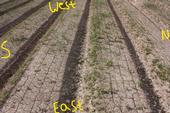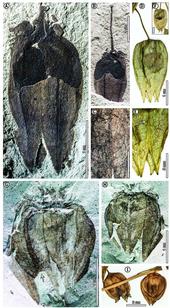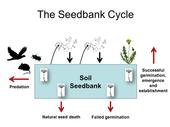- Author: Pratap Devkota

I visited an onion field where I saw this interesting emergence pattern with annual bluegrass (Poa annua L.). Onion beds are listed in east-west orientation (as seen in pictures). We can see annual bluegrass emergence only on the south facing slopes and none on bed-tops or north facing slopes. These pictures were taken around noon, the exact time was 12:44 PM. I assume that cultural and irrigation practices are same throughout the field. The only difference I observed was north facing slopes were shaded, but the bed tops and south facing slopes had ample light. With this situation, I am wondering what could be the possible reason for annual bluegrass to emerge on the south facing slopes but not on the bed-tops and north facing...
- Author: Guy B Kyser

This is only somewhat weed-related... just an excuse to post some photos of fossil tomatillos, from the days when Africa and South America formed the single continent Gondwanaland. If you have lanceleaved groundcherry (Physalis lancifolia) or one of the other Physalis species, this is where it came from.
- Author: Lynn M. Sosnoskie
This is the abstract and a poster from a presentation that I made at the 2016 Weed Science Society of America meeting in San Juan, PR. The results were generated from one run of each of the experiments. At this time, all of the studies have been replicated, the data is being analyzed and the manuscripts are in preparation.
JUNGLERICE (ECHINOCHLOA COLONA) GROWTH AND DEVELOPMENT IN RESPONSE TO TEMPERATURE AND SHADE.
- Author: Lynn M. Sosnoskie

When we think about weed control in crop production, we often think about 'short-term' result, i.e. weed control after 30 days, weed control after 60 days, weed control at harvest, etc. But weeds and weed control efforts in one crop can significantly influence the density and composition of weeds in following years. The carryover between commodities and seasons is accomplished via the weed seedbank, which serves, in my opinion, as the memory of crop production practices. Weed control successes and failures are reflected by changes that occur in this genetic reservoir. In good years, weeds are successfully controlled and few to no seeds enter the seedbank; in bad years, when weeds escape management strategies, rogue plants...
- Author: Chris McDonald
I'm sure you've noticed that different years have dominant weed species. For example this year in Southern California Russian thistle (aka tumbleweed Salsola tragus among other Salsola species) is abundant in many areas. Other years it is only moderately abundant and some years it seems to hardly hang on. The obvious question is why? Why is there so much variation in abundance between years?
Fortunately for us people have been working on this issue for a while and have a few general answers for us. Since the bulk of weeds in California are annuals I'll limit my discussion to those plants.
The seeds of annuals germinate only under a certain range of environmental conditions....


